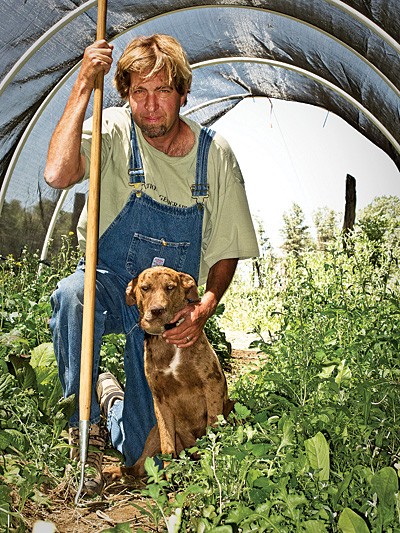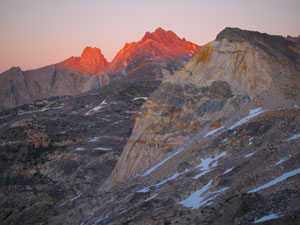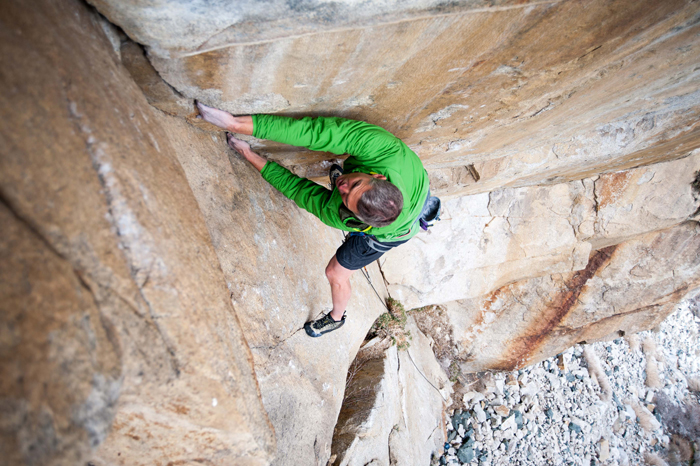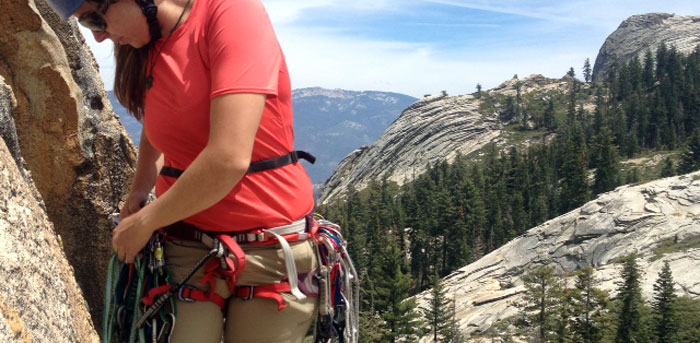- Tahoe’s Nevada Beach Tops the List of Hard-to-Book Campgrounds - 07/17/2024
- Cannabis Watershed Protection Program Cleans Up Illegal Grow Sites - 07/10/2024
- French Fire - 07/05/2024
Charmed by a stray catahoula hound, an Eastern Sierra farmer searches for a new canine climbing companion
Words and photographs by Bruce Willey
About 20,000 years ago, give or take, a wolf decided to hell with spending all day hunting. Why not instead hang around these groups of semi-sophisticated apes who use hunting clubs and arrows? In return for helping out with a few chores such as locating food and a few well-placed barks at the lions creeping around camp, the wolves could pick up a few scraps and bones, not to mention far more time for long naps. The symbiosis worked all too well.
Fast forward to early this summer and this less than sophisticated ape found himself staring into the eyes of a catahoula hound. He was sick and when I patted him my hand reeked of dead squirrel. His prison papers from the pound said he’d been given up because he “was an aggressive herder of livestock.” This seemed an impossible accusation for such a small, frail, skinny pup. Despite his sorry shape, to me the dog looked wholly promising.
This wasn’t the first time I’d had a run-in with a catahoula leopard dog. Three years earlier a dog of unknown origin showed up in my front yard. Around the dog’s collar was a piece of rope, frayed and dirty. I took it for a stray. The dog himself (after looking under the hood) was mottled grey and brown with big webbed paws and an oversized head. I gave him a drink of water and he lapped it down quickly, looking up at me with such kindness that I felt, at the risk of slipping poorly on a balmy patch of sentimentality, nothing short of an instant connection with the dog.
I figured the dog would have some water and then be on its way to wherever it was going. Leash laws? What be-damned leash laws? Many local dogs are often seen doing what they wish in the Owens Valley, which to my human perception consists of a cat chase or two, a dip in a glacier-fed creek, and running hither and thither for the good feel of it.
This is probably entirely wrong. A lot of dogs, no doubt, are simply—or rather, sophisticatedly—on the hunt for a glittery smell off a light pole (urban) or a fence (rural), taking in the smell of estrus of a heated and perhaps amenable bitch or the acrid testosterone levels of a male indicating intent of territory. The 220 million scent cells per all-powerful nose (in comparison to our mere five million) must blissfully rapture them into the nimble world of dog.
But instead it stayed. It lay down with a great sigh and preceded to ogle me while I worked. I looked over its coat (clean), its heavy tongue (healthy) and its glassy eyes (jaundice?!).
I Google-searched “dogs glassy eyes.” A few pecks down I noticed a picture of a dog that looked very much like the dog before me. I’d never heard of the breed before.
For good reason I’d resisted the urge to get another dog after witnessing my Karla, a German Shepard, die a long painful death due to hip displacement 20 years ago. With dark thoughts now, I hear her back claws dragging on the sidewalk. Though she was no doubt in intense discomfort, even terrible pain, Karla insisted on taking a walk with me. We walked slowly at dusk, she behind me while I talked to her in quiet, reassuring tones. We found some grass and sat down while I rubbed behind her ears. It was the last walk we would take.
That heart-wrenching story aside, dogs can put a real damper on your freedom. It always perplexes, even dismays me a little, to see guy walking his dog with a plastic bag and a pooper-scooper. It calls into question the master/dog continuum and human dignity. Of course it’s the right and proper thing to do if you’re a dog-owner, the latter a term that completely justifies the good deed of picking up shit in your leisure time.
The Internet search for catahoula yielded more information than I could take in one sitting, but a few things stuck out. For one, the hound is Louisiana’s state dog and appropriately enough possess webbed feet, making them premier swimmers.
The breed’s history borders on the mythological. This from the snobbery of the Official United Kennel Club: “They are believed to be descended from crosses between Native American dogs, Red Wolves (some of whom lived as pariahs on the outskirts of Indian villages), and the dogs brought to the New World by Spanish conquistadors, probably mastiff-types and sight hounds.”
Which is another way of saying the catahoula is basically a versatile mutt with the papers to prove it.
That day I coaxed the dog in the truck and went climbing at the Buttermilk boulders above Bishop. The dog was hesitant at first, but soon was pulling off moves that would give a bighorn sheep pause. I began to really like this dog and by late afternoon gave it a name: Birkie, after Birch Mountain that rises above Big Pine.
For the next four days we climbed, played fetch, swam in creeks and lakes, played fetch some more. I never became a “dog owner” because Birkie insisted on taking a crap once he was on Los Angeles Department of Water and Power land. Birkie was never short of pure loveliness and at night he slept at the foot of our bed where we heard and fathomed his dreams.
On the fifth day, in an effort to do right and perhaps get Birkie some shots and a license for his new collar, I took him to the dog shelter. As it turned out someone had called, someone who knew his real name, someone who would be right over to pick Birkie up. I threw a stick across the dusty parking lot of the shelter and then sat down waiting for Birkie to run back to my side. He liked to be petted on his large cheeks, then across the top of his head between his floppy ears. I sadly obliged.
When the owner arrived, Birkie didn’t even move when his rightful name was called. In fact, I can’t recall what the man called his dog. But eventually Birkie was persuaded in the back of the truck. I went inside the shelter and the two women in the office recognized my sorrow.
“We’ve got a few really nice dogs up for adoption,” one of them said. They trotted out some big dogs, the size of Birkie. “Let me think on it,” I said.
And I did. But I was unable to get Birkie out of my thoughts. Friends come and go, some for a few weeks, some for decades. It’s the sad truth of it all. Birkie had visited for a little less than a week, but in that time I could feel the earth going around the sun; had smelled the sagebrush with more clarity and perhaps more canine clairvoyance than I had ever mustered. To me Birkie will always be lost in the sense of the J.R.R. Tolkien saw, “Not all those who wander are lost.”
So for the next few years my wife scanned the dog shelter websites in search of a replacement for Birkie. After him, we were convinced that another catahoula was the right, perhaps the only kind of dog for us. But we wondered: would we ever be able to do a multi-pitch climb or go for an extended stay in the backcountry? National Parks were out unless we wanted to walk around the sights close to the road with a leash. So would Indian Creek, Utah, our annual post-spring hangout.
We weighed the pros and cons, all of which became a useless discussion once we found a catahoula at a shelter awaiting adoption, a dog that had been rescued from death row in Modesto.
We traveled over the big hill as soon as the weather cleared and found him living amongst 40 or so other dogs, skinny, sick, but with his big personality still intact. We gathered him in the car for the long drive home over 9,600-foot Sonora Pass.
At the Walker River we stopped to give him a drink of water and a name. Because he’d been caged for so long, his back legs splayed out and he walked like a cowboy who’s been on a horse all his life. Nevertheless, he walked into the water with little hesitation. We named him Birkie.
After a host of shots and de-worming pills, Birkie’s health improved. We gave him a dog pack, which he wore on the approaches to the climbs in Pine Creek Canyon. With the pack on he became focused, trading playful puppyhood for working-dog status. And he took to the talus, his wide feet gripping edges and pawing across slabs like sticky rubber.
His confidence grew, perhaps too much. Gearing up for a climb on the PSOM Slab, I watched in horror as Birkie casually walked a diagonal line across a 5.8 steep slab, a 40-foot fall should he slip. It was like finding out your son likes to solo rock climb. I was afraid that if I called him he would slip when he turned around. But his paws smeared on the rock and he came back to a stern warning that he misunderstood for not sitting when asked.
At first he anxiously whimpered when we left him on the ground, but gradually he got the idea that what goes up must come down. Simple physics for sure, but pretty good for a dog.
And once he understood that snow was a good medium for sliding it was pretty hard to tear him away from a snow patch. A Cajun dog taking to snow: who would have thought?
John Muir had his Stickeen and Peter Croft has PeeWee. Birkie won’t become famous like those dogs. Much depends on the dog’s owner, or rather its companion, which is the politically correct way to say it.
But Birkie’s reputation continues to grow with the other dogs at the crags. He’s certainly met more people and dogs in his short lifetime than I have in my long one. I suppose he has to; his time on this earth is short, measured in dog years.
So Birkie is growing up pretty fast, each day full of new experiences whether on the farm with the cows, goats, and chickens or out at the crags, wandering the sagebrush slopes or navigating through a maze of talus. One day soon we’ll take him mountaineering when he has a sense of mortality under his collar.
For now, though, he’s just a dog enjoying being one.
Bruce Willey is a farmer living in Bishop who still dabbles in climbing, writing, and photography when he’s not tending his crops. See more of the farm (and the farm dog) at www.bishopcreekfarms.com.
Dog Etiquette in the Great Outdoors
All the proper wilderness etiquette that applies to humans also applies to dogs. Ask yourself: would you dig a hole in a nice green meadow? Would you shout at the top of your lungs? Would you poop on the trail or near a water source? Would you bite a fellow hiker if he were moving up the trail faster than you? If you answered yes to any of the above, stay home and camp in the backyard.
Leashes: Always obey leash laws. National Parks mandate that your dog be on a leash at all times and don’t allow them on backcountry trails. Even in places where leashes are not required, carry one in your hand. That way you can immediately put your dog back on leash should you run into another troubled dog or hiker who is uncomfortable with dogs.
Poop: Just as you would pack out or bury your own waste, always do the same for your dog.
Behavior and Training: Don’t bring a dog into a wilderness area until you have absolute control of your dog by voice command.
Barking: Keep your dog from disturbing the peace at all times.
Wildlife: If your dog chases wildlife, keep it on a leash. Period. And no barking.
Pack Animals: When a pack train approaches, keep your dog on a leash and don’t allow it to bark.
—Bruce Willey















